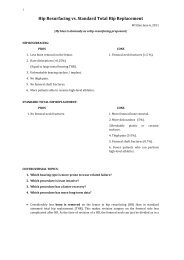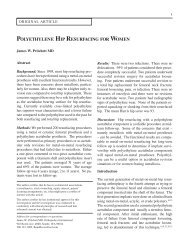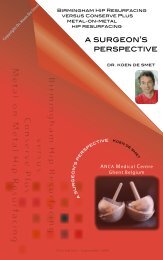Hip and Knee Arthroplasty - Surface Hippy Guide to Hip Resurfacing
Hip and Knee Arthroplasty - Surface Hippy Guide to Hip Resurfacing
Hip and Knee Arthroplasty - Surface Hippy Guide to Hip Resurfacing
Create successful ePaper yourself
Turn your PDF publications into a flip-book with our unique Google optimized e-Paper software.
difference is also evident when comparing the<br />
seven year cumulative percent revision for each<br />
of these procedures (4.2%, 5.4% <strong>and</strong> 5.9%<br />
respectively) (Table HG5).<br />
Thrust plate procedures, because they are quite<br />
different in design from the other types of<br />
primary hip replacement, are considered<br />
separately. Only a small number (172) of these<br />
procedures have been recorded by the Registry.<br />
The number of revisions per 100 observed<br />
component years for this procedure is 0.6 <strong>and</strong><br />
the cumulative percent revision at 7 years is<br />
3.0% (Tables HG4 <strong>and</strong> HG5).<br />
Outcome by Primary Diagnosis<br />
This year the Registry is presenting outcomes<br />
stratified by primary diagnosis for the first time.<br />
These analyses are presented for primary<br />
conventional <strong>and</strong> resurfacing <strong>to</strong>tal hip<br />
replacement only. These procedure types have<br />
been selected as enough procedures have been<br />
undertaken with a variety of different diagnoses.<br />
Primary partial hips have not been included<br />
because almost all of these have been<br />
undertaken for fractured neck of femur.<br />
The Registry has classified 11 different primary<br />
diagnoses for primary conventional <strong>to</strong>tal hip<br />
replacement (Tables HG6 <strong>and</strong> HG7 <strong>and</strong> Figure<br />
HG4). The outcomes of the five most common<br />
diagnoses were compared using osteoarthritis<br />
(OA) as the compara<strong>to</strong>r diagnosis. Fractured<br />
neck of femur, avascular necrosis (AVN) <strong>and</strong><br />
rheuma<strong>to</strong>id arthritis all have a significantly higher<br />
risk of revision compared <strong>to</strong> those undertaken for<br />
OA. There is no significant difference between<br />
OA <strong>and</strong> developmental dysplasia of the hip (DDH)<br />
for conventional primary <strong>to</strong>tal hip replacement.<br />
Three diagnoses were compared for primary<br />
resurfacing hip replacement (Tables HG8 <strong>and</strong><br />
HG9 <strong>and</strong> Figure HG5). Both AVN <strong>and</strong> DDH have<br />
a significantly higher risk of revision compared <strong>to</strong><br />
resurfacing procedures undertaken for OA. The<br />
five year cumulative percent revision for DDH is<br />
four times greater when a <strong>to</strong>tal resurfacing<br />
procedure is used compared <strong>to</strong> a primary<br />
conventional <strong>to</strong>tal hip replacement (12.0%<br />
compared <strong>to</strong> 3.0%).<br />
17






